#shanqun
Photo




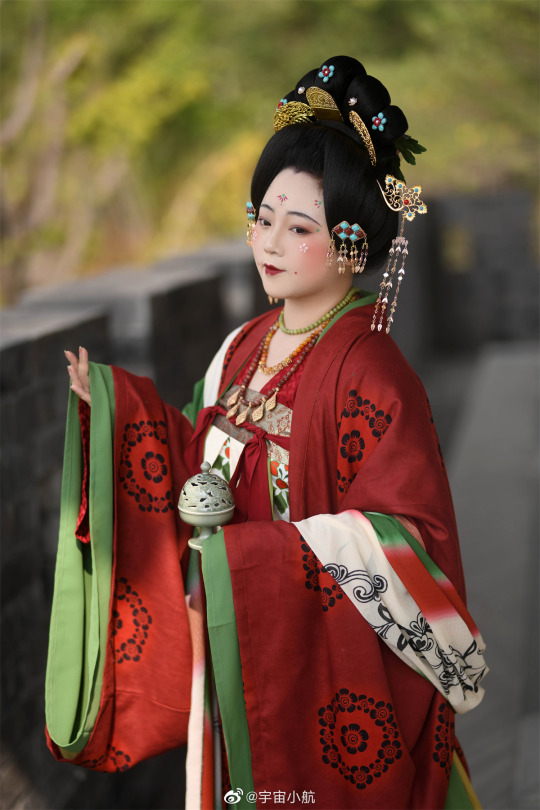



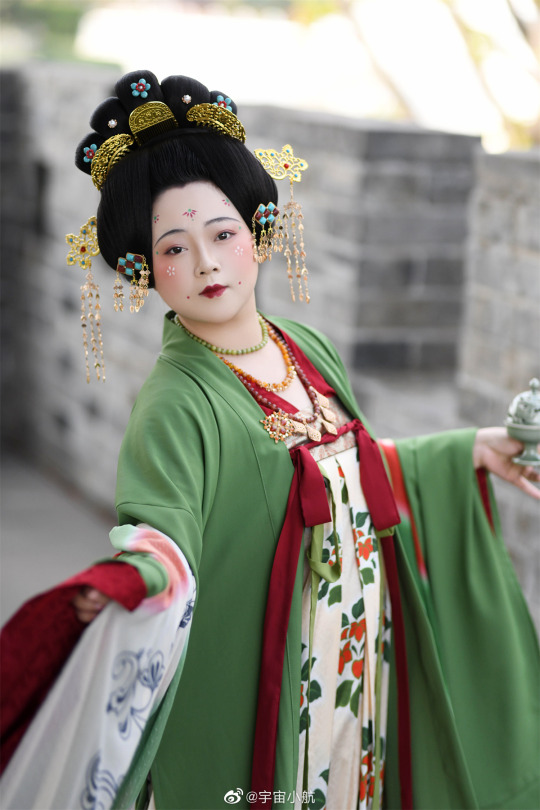




【Historical Artifact Reference】:
Tang Dynasty Dunhuang Murals Woman Donor

[Hanfu · 漢服]China Tang Dynasty (960–1127 AD) Chinese Traditional Clothing Hanfu & Hairstyle Reference to Dunhuang Murals 【 佳期阁-天祈】
_______
👗Hanfu & Photo: @佳期閣
🔗Weibo: https://weibo.com/1774911441/MieqBg2r5
🛍️Tabao:https://item.taobao.com/item.htm?spm=a1z10.3-c.w4002-21517525888.22.16351c817LQotd&id=693956332870
_______
#Chinese Hanfu#Tang Dynasty (960–1127 AD)#hanfu#Tang Dynasty Dunhuang Murals Woman Donor#hanfu history#Chinese Costume#chinese traditional clothing#hanfu accessories#chinese historical fashion#china#chinese history#shanqun#Guangxiushan#pibo#chinese#chinese art#historical hairstyles#chinese aesthetics#chinese fashion#漢服#汉服#佳期阁-天祈
266 notes
·
View notes
Photo
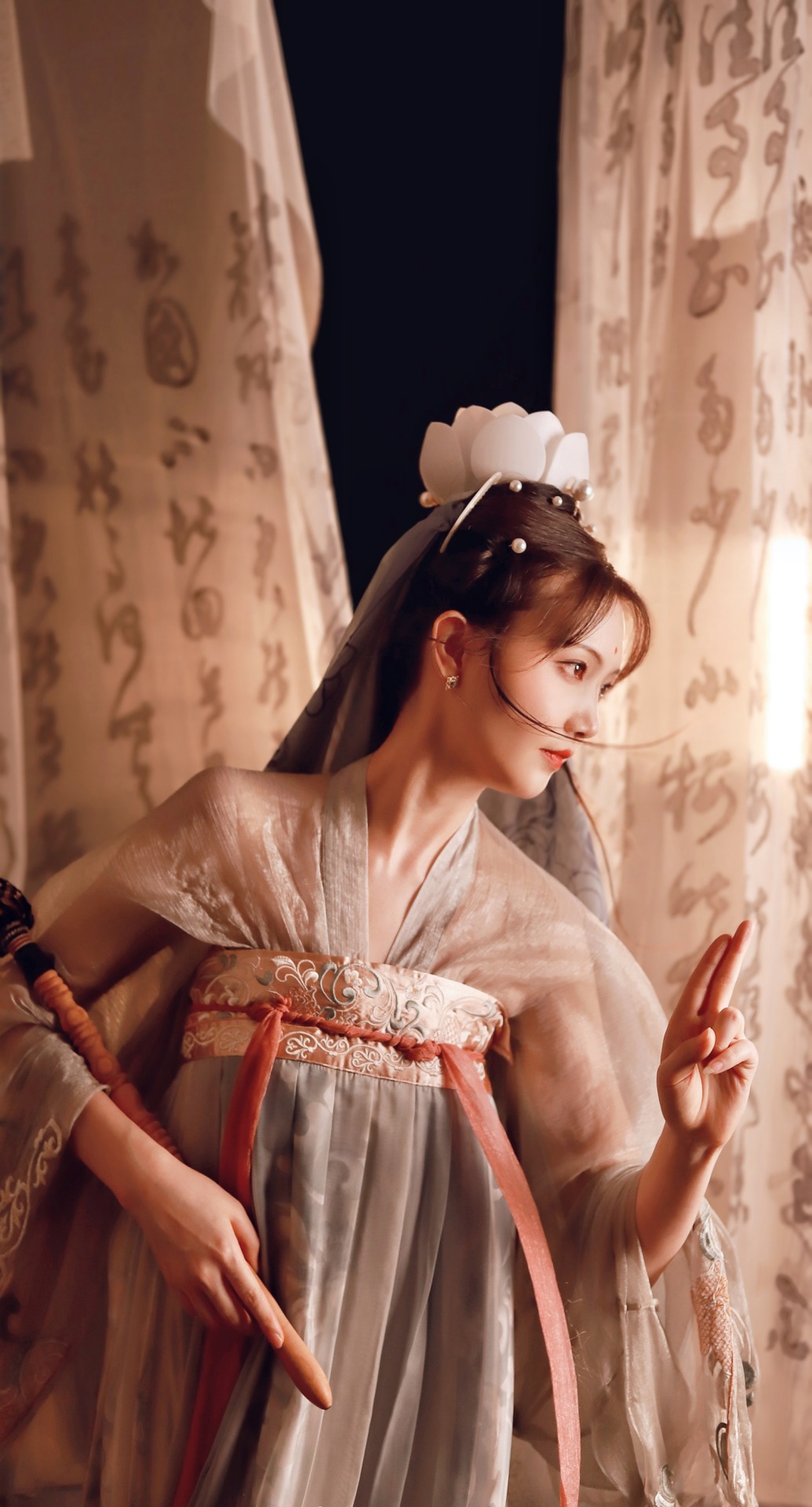

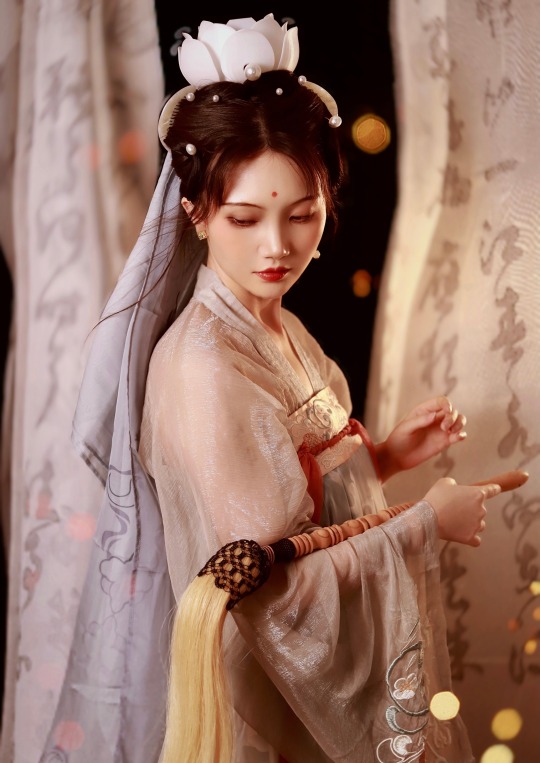



𝒯𝒶𝑜𝒾𝓈𝓉 𝐼𝓃𝓈𝓅𝒾𝓇𝑒𝒹 𝓂𝒶𝓀𝑒𝓊𝓅 𝓈𝑒𝓇𝒾𝑒𝓈 𝒷𝓎 晓十_玄影任雲蹤
231 notes
·
View notes
Photo


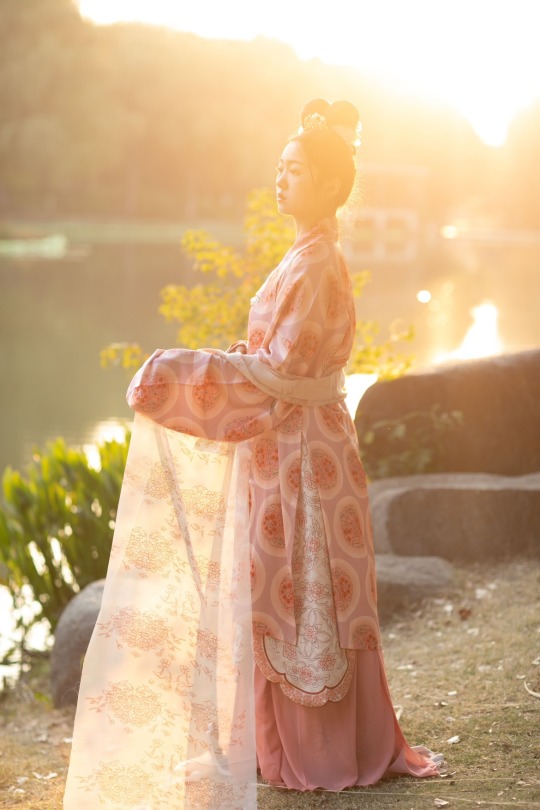
五代后周女性装束 Five Dynasties (Hou Zhou Country) by 青泠谷 原创汉服店
23 notes
·
View notes
Text





Summer Qixiong Shanqun - Wei Mao
157 notes
·
View notes
Note
If you don’t mind me askin, do own and hafus? If not, do you have any favourites?
Hi! Thanks for the question, and sorry for taking ages to reply! (image via)

Yes, I do own a few hanfu. Here's a list of hanfu & hanfu accessories I currently own:
3 quju + 1 matching dachang
1 jiaoling (cross-collar) ruqun set (jiaoling ru + banbi + qun + pibo)
2 duijin (parallel-collar) shanqun sets (duijin shan + moxiong/dudou + qun + pibo)
1 Song dynasty-style set (beizi + shan + moxiong + baidiequn)
1 mamianqun
1 hanyuansu one-piece dress
1 pair of shoes
A few hairpins & a necklace
My favorite is probably the Song dynasty-style set by 上遥居 that I got from Nüwa Hanfu. It has a lovely color palette of lilac, pink, and white, light & ethereal fabrics, and exquisite floral embroidery & pearl accents. Perfect for spring!:
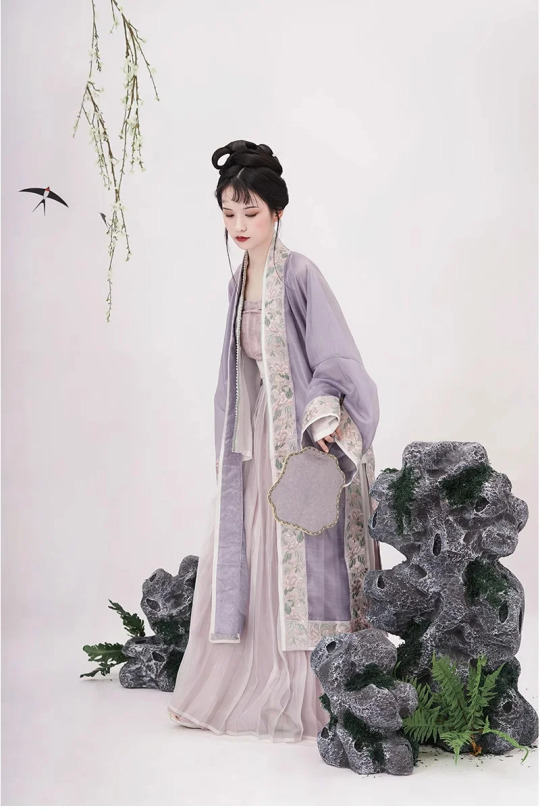
I'm also in love with this gorgeous handmade ronghua hairpin I recently got from 卿子手作 (seriously, the photos don't do it justice):

I'm looking into getting a bag next, since I realized I don't really have a matching bag to wear with my hanfu. In particular, I've been eyeing this cute embroidered swallow-motif crossbody bag from 瞳莞:
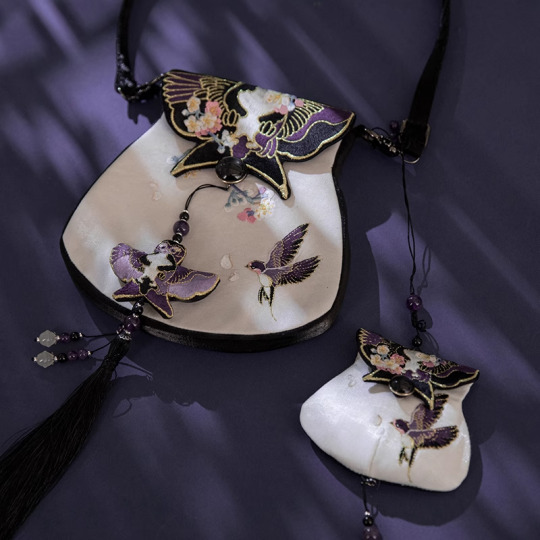
Feel free to share favorite hanfu acquisitions in this post! ^^
#hanfu#hanfu accessories#personal#ronghua#bags#hanfu recommendations#>100#ask#reply#chinese fashion#chinese clothing#china
114 notes
·
View notes
Text
Abridged History of Qing Dynasty Han Women’s Fashion (part 1: Late Ming & Shunzhi Era)
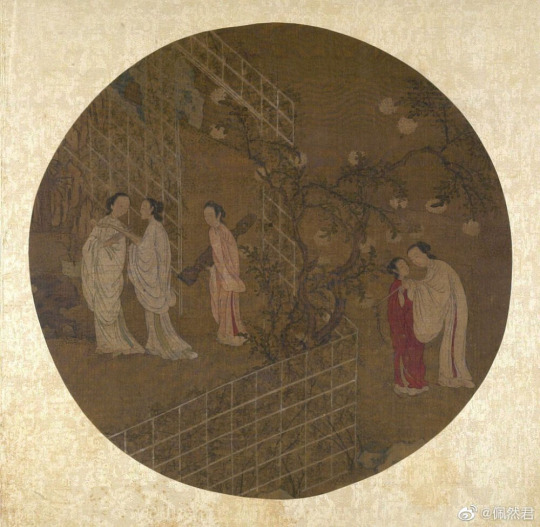
Intro
Finally got around to writing this series! Couple notes before we begin. I will only discuss civilian fashion and not court dress because 1) Qing court dress is well documented and there are plenty of other people/blogs/articles that explain it better than I ever could 2) court dress doesn’t really count as fashion because it serves ceremonial/religious/political purposes and is not supposed to change. The overwhelming majority of English language information about Qing Dynasty clothing is about court dress and Manchu women’s fashion, so I will be doing a disservice to the era if I continued that line of discussion. It should be noted that most literature on court dress and Manchu women’s fashion is not flawless either; court dress is often flattened to “dragon robes” by white historians despite it not being a legitimate fashion history term, and much information about “Qing Dynasty” Manchu fashion is really about that of the early 20th century, the Republican era. That is outside the scope of discussion for this series. Instead, I would like to shed some light on the life and times of Han women’s fashion during the Qing, something strictly kept out of the canon of Chinese fashion history until very recently.
Before we jump into it, we need some context. Prior to the establishment of the Qing Dynasty, China was ruled by the Ming Dynasty under ethnically Han (majority ethnicity in China nowadays) rulers since 1368. A collection of Jurchen tribes from what is now northeastern China and parts of Siberia, who later called themselves the Manchus, conquered China in 1644. In order to solidify their power, the new Manchu rulers forced Han Chinese men to adopt Manchu style clothing and hairstyles, but Han women were allowed to continue wearing Han style clothing, which is why the second half of the 17th century appears to be the continuation of the late Ming Dynasty aesthetic.
However, the early Qing was undeniably distinct from the Ming Dynasty, and I will not tolerate anybody calling clothes from this era “Ming style”. It could potentially be considered hanfu, as it was worn by Han women exclusively----something up for the community to decide----but it definitely did not belong to Ming Dynasty proper. Although in the 1640s and 50s some resistance forces in the south (dubbed “Southern Ming”) were still around, it’s not really worthwhile to make the distinction for womenswear, so let’s place it under Qing Dynasty for convenience. I have berated 18th century erasure quite frequently and passionately in the past (and it’s often extended to the 17th century as well), if you have seen any of those posts you would know that Qing Han women’s fashion prior to the 19th century is routinely mislabelled as Ming because it didn’t adhere to 20th century stereotypes about the “Manchuness” of Qing clothing and supposed Chinese backwardness in the colonial imagination of the time. Because of this reason, please do not be surprised if any of the images from the first couple posts of this series appear to be depicting what is commonly considered “Ming Dynasty hanfu”; they do not, they were from the Qing, plain and simple. It’s often simply because people don’t pay enough attention to the dating of artworks.
I will use emperors’ reign years as a guide for eras in this series because oftentimes that’s the most accurate dating that exists for artworks (many are unclear as to the exact year/decade they were made in), though I would recommend using exact dates instead of emperors wherever possible.
Fashion of the Ming-Qing transition
Han women’s fashion of the very early Qing had significant overlap and continuity with the late Ming. I’m not very knowledgeable on the minutiae of Ming Dynasty clothing so do add/correct anything. The standard ensemble for Han Chinese women was the 袄裙 aoqun (alternatively named 衫裙 shanqun) ensemble consisting of a robe and a skirt. In the 1620s and 30s, the cut of the robe was extremely generous, the hem hitting about knee length and the sleeves almost touching the ground. The sleeves of this era (and often throughout Chinese history) were longer than that of the length of the wearer’s arms, meaning that the wearer is required to grab the cuffs of the sleeves in order to facilitate the use of their arms. Many consider this inconvenient nowadays, but keep in mind that these robes with huge sleeves were made for wealthy people who hired servants and didn’t need to do physical labor. Working class people wore shorter, tighter sleeves that could also be held up by a garter.
The robe had a fitted tall standing collar, as opposed to the cross collar popular in previous centuries. The standing collar in the 1620s and 30s was soft, unstiffened and closed by two 子母扣 zimukou, metal clasp buttons, one at the bottom of the collar where it touched the bodice and one at the middle of the collar. Collars with only one button also existed, and these would be worn folded over. Gold or silver piping on the collar began to be popularized on the collar. Robes were closed at the side under the right armpit, commonly with tie strings. The placket forms a straight diagonal line from the collar to under the armpit. In the 17th century, robes were commonly plain and unicolor, with only brocade/embroidery in the same color. When decorative patterns were used, they were frequently in a repetitive arrangement of small clusters of motifs. Light pastel colors or white were very popular. Undergarments whose cuffs could be seen on the outside were commonly red, providing a contrasting flash of color to the otherwise light and plain ensembles.

Illustration from the late Ming novel 鸳鸯绦, showing the large sleeves popular at the time.

Late Ming women’s robe from the Confucius Estate collection.
The skirt was usually of 马面 mamian construction, basically two pleated pieces of fabric with two unpleated sections at the middle each, called 裙门 qunmen, that are sewn onto a waistband with one unpleated section overlapping, creating a wrap skirt. It has ribbons attached to each end of the waistband and was closed by wrapping the skirt around the waist and tying with the ribbons. Throughout much of the Ming Dynasty, mamian skirts were decorated using 裙襕 qunlan, a horizontal row of gold brocade or embroidery across the skirt, whose placement and widths varied depending on the trends of the decade. In the 1620s and 30s, skirts became increasingly simple, and plain white skirts were all the rage. Decorative features like qunlan were frequently relegated to formal dress.
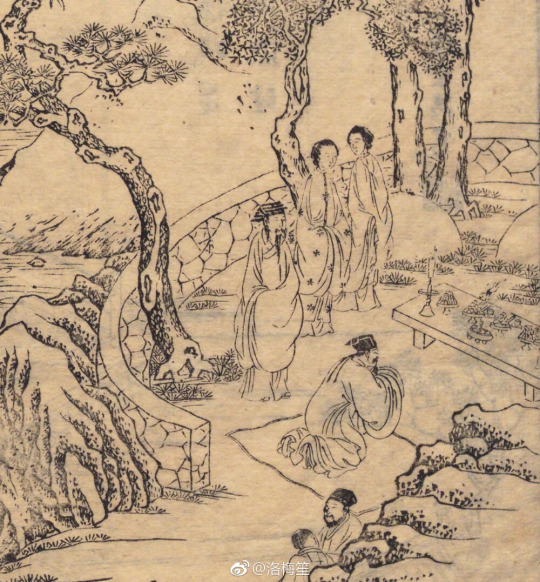
Illustration for the Chongzhen era novel 醋葫芦. The repetitive decorative patterns could be seen on the robe of the lady to the left.
Women’s hairstyle of this period is referred to as 三绺梳头 or “hair in three sections”, where the front of one’s hair would be divided into three sections, top, left and right, which would then be tied and coiled at the back, sometimes forming an elongated end at the bottom called a 燕尾 or “swallow tail”.

Late Ming/early Qing painting showing two fashionable women. The flash of red from the under robe is visible.
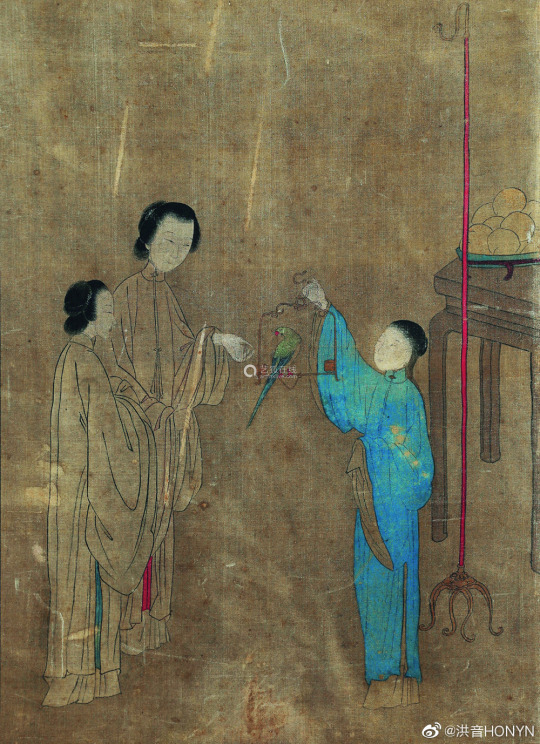
Beside the skirt and robe, women could layer a 披风 pifeng on top of the robe. These were equally generous in cut as the robe but had a 直领 zhiling, parallel collar, and were closed by tie strings or bigger decorative clasp buttons at the center front. It usually had a wide facing at the collar, which in the 1620s and 30s were often plain and in the same color as the garment.
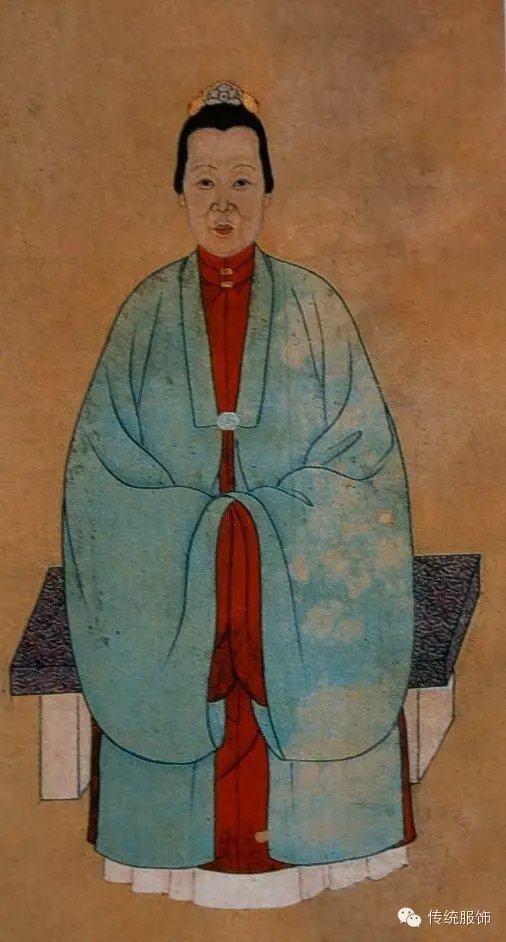
Mid 17th century portrait. This lady is wearing a plain red robe with gold buttons and piping, blue pifeng and plain white mamian skirt.
By the 1640s, the width of the sleeves had become smaller, and hairstyles became gradually fuller and more voluminous at the top, beginning the transition to the Kangxi era. The diagonal placket on robes began to be replaced by closures at the center front, often held together by tie strings.
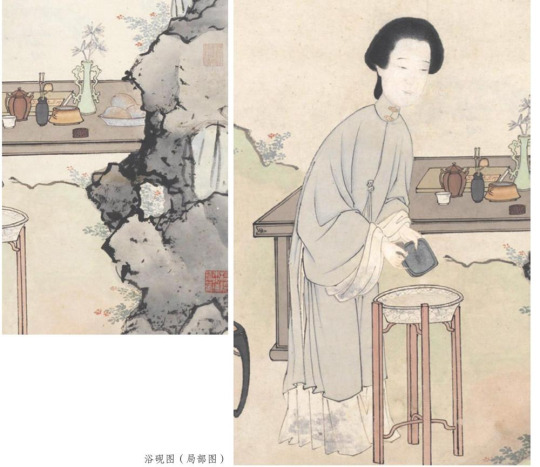
Section of 浴砚图 by 蓝瑛 Lan Ying and 徐泰 Xu Tai, 1659. We can see the center front closure with tie strings instead of the diagonal placket closing under the right armpit popular in previous eras.
Around this time, robes made of sheer fabric were being popularized as informal loungewear for warmer weather. Sheer robes were not proper enough to be worn outside, but we can catch a glimpse of these robes along with the undergarments beneath in romantic paintings with a domestic setting. The principle women’s undergarment for the upper body remained a 主腰 zhuyao, a tube top-like garment that provided bust support. It could have shoulder straps and was usually closed at the back with tie strings, though closures with cloth buttons became increasingly common throughout the Qing.

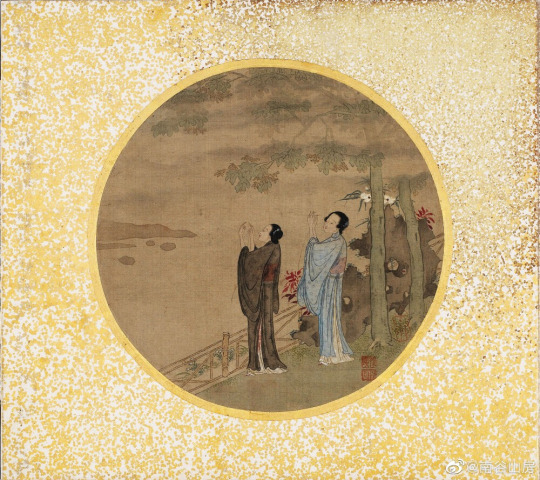
Shunzhi era painting series by Sun Huang (the cover image for this post is from the same series), showing a lady and her maids in lounging clothes, the zhuyao visible under the sheer robe.
--
I’m not as knowledgeable about the earlier parts of the Qing Dynasty as the later ones, so as always feel free to correct or add anything to this post :))
#qing dynasty#17th century#ming dynasty#shunzhi era#chongzhen era#abridged history of qing dynasty han women's fashion#chinese fashion#hanfu#fashion history
199 notes
·
View notes
Link
ilustrasi oleh ivoci, foto oleh Peggy_Marco Qixiong ruqun (Hanzi: 齐胸襦裙 ; Pinyin: qí xiōng rú qún), yang juga dapat disebut sebagai Qixiong shanqun (Hanzi: 齐胸衫裙 ; Pinyin: qí xiōng shān qún) juga dikenal sebagai “ruqun setinggi dada” adalah satu set pakaian dalam hanfu, pakaian tradisional Tiongkok yang dikenakan oleh orang Tiongkok Han. Qixiong ruqun adalah salah satu model dari ruqun (Hanzi: 襦裙 ; Pinyin: rú qún). Qun yang digunakan dalam qixiong ruqun umumnya diikat di atas payudara. Pakaian ini dipakai oleh wanita selama dinasti Sui , dinasti Tang dan periode Lima Dinasti dan Sepuluh Negara. Model pakaian ini juga sering dipakai kembali pada awal dan pertengahan dinasti Ming. ilustrasi oleh ivoci Sejak dinasti Han dan Jin, pinggang rok biasanya diikat di pinggang, sedangkan di dinasti Sui, dinasti Tang dan Lima Dinasti, rok diikat jauh lebih tinggi, biasanya di atas dada atau di bawah ketiak. Beberapa catatan sejarah pakaian menyebutnya sebagai ruqun pinggang tinggi. Kemudian, namanya diubah menjadi qixiong ruqun, sesuai dengan inspeksi dan sertifikasi yang dilakukan oleh orang-orang. Qixiong ruqun adalah bentuk khas hanfu wanita di dinasti Tang . Qixiong ruqun dari dinasti Tang juga diperkenalkan di Korea selama periode Silla dan juga diperkenalkan di Balhae. Qixiong ruqun juga diadopsi oleh wanita Khitan dan terus dipakai di dinasti Liao bahkan setelah jatuhnya dinasti Tang. Di zaman modern dengan meningkatnya popularitas hanfu, qixiong ruqun mendapatkan popularitas tinggi di kalangan wanita muda. Qixiong ruqun modern kontroversial karena kelangkaan pakaian sejarah yang digali. Sekarang, Qixiong ruqun dapat ditemukan dalam rok one-piece dan two-pieces. Qixiong ruqun gaya one-piece adalah rok one-piece tradisional Tiongkok yang diikat seperti rok lilit. Qixiong ruqun gaya dua potong terdiri dari dua potong kain. Ini disajikan sebagai dua potong kain yang dijahit secara tidak lengkap di samping untuk membentuk bagian belakang dan depan dan dengan dua set ikatan. Cara mengikat qixiong ruqun dua potong berbeda dengan rok one-piece tradisional: pertama, bagian belakang diikat, kemudian bagian depan diikat. Hiburan Pakaian gaya qixiong ruqun sering digambarkan dalam kostum yang dikenakan oleh aktor dan aktris dalam drama televisi Tiongkok , dalam film, dan bentuk hiburan lainnya. Mereka juga kadang-kadang digambarkan dalam drama Korea. Shen Yue dengan qixiong ruqun Song Yi dengan qixiong ruqun Yu Shuxin (Esther Yu) dengan qixiong ruqun Penggambaran media Qixiong ruqun telah digambarkan dalam film dan serial televisi, termasuk Curse of the Golden Flower (2006), Jumong (2006), Queen Seondeok (2009), The Empress of China (2014), Wu Xin: The Monster Killer (2015), The Longest Day in Chang’an (2019), The Untamed (2019), Court Lady (2021), The Long Ballad (2021), dan masih banyak lagi. Zhao Lusi dengan qixiong ruqun dalam drama The Long Ballad (2021) Li Yitong dengan qixiong ruqun dalam drama Court Lady (2021) Ai Ru dengan qixiong ruqun dalam drama The Longest Day in Chang’an (2019) Artikel pertama muncul di: Tionghoa Indonesia - Budaya dan Tradisi Tionghoa Indonesia Pada: Pakaian Tradisional Tiongkok, Hanfu Wanita: Qixiong Ruqun / Qixiong Shanqun
1 note
·
View note
Text
5 Types of Traditional Chinese Clothing & Dress
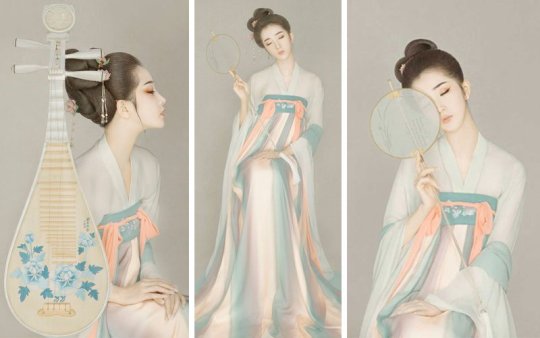
The story of clothing is one of the fascinating developments in human history. Each country in the world has its unique traditional costumes, which can identify specific histories and cultures and enable people to distinguish different citizens.
China is a country with a long history, and many ethnic minorities have their own national culture. The mutual influence of these different cultures has created rich textures and fabrics in history, which has brought about significant changes and glories in Chinese clothing.
Chinese traditional costumes were formed and developed under the interaction between the outside world and China's own dynastic traditions.
Each Dynasty had different boundaries, social values, social norms, etc. As a result, many aesthetic standards were based on the circumstances of a particular dynasty (social, geographical, economic, political). This is the main reason why there are so many styles of traditional Chinese dress.
5 kinds of traditional Chinese clothing
Before we explore the world of traditional Chinese clothing, it is necessary to learn the five most classic categories. They are Hanfu, Cheongsam, Tang Zhuang, Zhongshan Zhuang, and ethnic customs.
Each category has its own production process, and there are significant differences between different types or when the same model is compared at different times.
This article will briefly introduce each category. By reading the following, we can build the basic framework of traditional Chinese clothing.
The name of Hanfu comes from Chinese, which means "clothes of the Han people" and includes all types and styles of traditional clothing worn by the Han people.
The common ancestor of the Han people in Huaxia. Huaxia is the name of the original alliance of agricultural tribes in the Yellow River valley. The term Huaxia represents a corporate alliance of neolithic farming tribes, Hua and Xia, who lived in the central plains in the middle and lower reaches of the Yellow River in northern China.
Hanfu, like its definition, was born at the beginning of the development history of the Han people. Therefore, it has the most extended history among all the traditional Chinese clothing.
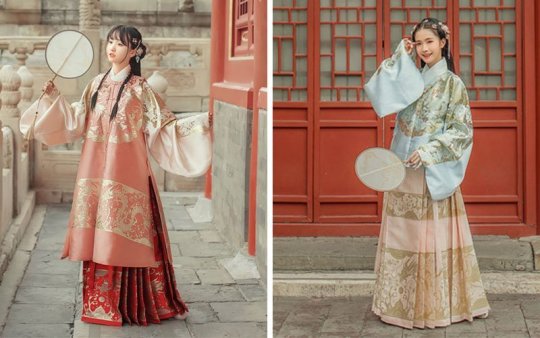
1, Historical Hanfu
Hanfu has a history of more than 3,000 years. From its history, Hanfu has been inextricably linked with silk, which is said to have been discovered by the Yellow Emperor's wife, Leizu.
From the Yellow Emperor (2969-2598 BC) to the Ming dynasty (1368-1644 BC), Hanfu dominated China's fashion world.
Each Dynasty had its own style and aesthetics. Such as the pre-qin period "Shenyi"; your clothes from the Qin and Han dynasties; Tiaowenjiansequn of the Wei dynasty; Bambi in Sui and Tang dynasties.
Some clothes were trendy in different dynasties, some were just a flash in the pan. In both cases, all Hanfu evolved and influenced each other to some extent.
Although there are many styles of Hanfu, each can be assembled with a suit of clothes.
Yi (衣) any open cross-collar garment, and worn by both sexes
Pao (袍) any closed full-body garment, worn only by men
Ru (襦) open cross-collar shirt
Shan (衫) open cross-collar shirt or jacket that is worn over the Yi
Qun (裙) or Chang (裳) skirt for women and men
Ku (裈) trousers or pants
Follows are the introduction of some Hanfu styles.
Zhongyi (中衣) or Zhongdan (中单) inner garments, mostly white cotton or silk
Shanqun (衫裙) a short coat with a long skirt
Ruqun (襦裙) a top clothing with a separate lower garment or skirt
Kuzhe (裤褶) a short coat with trousers
Zhiduo/Zhishen (直裰/直身) a Ming Dynasty style robe, similar to a Shenyi but with vents at the side and “stitched sleeves” (eg, the sleeve cuff is closed save a small opening for the hand to go through)
Daopao/Fusha (道袍/彿裟) Taoist/Buddhist priests’ full-dress ceremonial robes
Xuanduan (玄端) a very formal dark robe; equivalent to the Western white tie
Shenyi (深衣) a long whole-body garment
Quju (曲裾) diagonal body wrapping
Zhiju (直裾) straight lapels
Yuanlingshan (圆领衫), Lanshan (襕衫) or Panlingpao (盘领袍): closed, round-collared robe; mostly used for official or academical dress
reference wiki

2. Cheongsam or Qipao
The cheongsam is a kind of traditional dress, its history can be traced back to the 17th century. It is Manchu tights with distinctive Chinese characteristics. In the 1920s and 1930s, it was known as the "Mandas dress" and became popular among upper-class women in Shanghai.
The history of the cheongsam
In the qing dynasty, the Manchu, not the Han, ruled China. The rulers used an administrative division called the eight flags system. At first, only Manchu families were organized in the order, but above them were Mongols and Han Chinese.
The Manchus and anyone living under the eight banners wore clothes different from those of ordinary people. The garment is made up of robes similar to those of men and women and is called a robe.
For a time, under the laws of the Dynasty after 1636, and all Han Chinese had to wear Manchu men's hair, line up, and wear Manchu robes instead of traditional Han dress, or else they were sentenced to death.
In the 19th century, however, it was common for women to wear cheongsam voluntarily on both formal and casual occasions.
Today, the cheongsam is known for its exotic but straightforward lines and has inspired many foreign film adaptations. It is prevalent because it suits the figure of Chinese women very well; the line is simple, looks very elegant. Suitable for young and old people to wear throughout the year.
Modern women do not wear cheongsam as their daily wear. It is now only worn for formal occasions, such as weddings, parties, and beauty pageants. It is also used as a uniform by some Chinese restaurants, hotels, and airlines.
In China, cheongsam is usually a red wedding dress. Cheongsam is generally embroidered with exquisite gold and silver patterns. Brides in southern China wear a cheongsam or a two-piece makeover with elaborate golden dragons and phoenixes. Dragon and phoenix are the traditional wedding patterns favored by Chinese brides today.
3. Tang Suit
Tang suit, also translated as Tangzhuang, is often referred to as a modern Chinese jacket rather than a Tang dynasty.
Origin of name
Although the Tang suit is not the costume of the Tang dynasty, it has a particular relationship with the Tang dynasty. The Tang dynasty was one of the most prosperous periods in Chinese history. Therefore, people often use "Tang" to refer to traditional Chinese culture. For example, Chinatowns in the US or UK are also known as "Chinatown (Tang people street)".
Tang suit, as the name of Chinatown, represents a kind of dress with deep Chinese traditional culture.
Tang Suit History
The history of the Tang suit can be traced back to the early 20th century (late Qing dynasty). It is a combination of Manchu jacket elements and western jacket elements.
The Chinese government released a new unified system in 1929. Under this new system, the Tang suit became a kind of formal dress for Chinese men. Also around 1929, the media all over the world start to extensive reports and the introduction to the Tang suit. People all over the world began to think of the Tang suit as one of the most typical traditional Chinese clothes.
In recent years, with the diversification of Tang suit styles and production techniques, the Tang suit is becoming more and more popular not only In China but also in the world.
Tang suit appeared in many international events. In 2001, the Asia-pacific economic cooperation (APEC) meeting, all the leaders wore Tang suit, blue, bright red, and with China's national flower peony circular design. Besides, the Tang suit also appeared in the 2008 Olympic Games and some of the World Trade Organization meeting.
Also, Tang suit elements have appeared in many famous Kungfu films and TV series. Thanks to the joint efforts of designers and the cultural industry, the influence of the Tang suit has spread further and further.
4. Zhongshan Suit
The modern Chinese tunic suit is a style of male attire known initially in China as the Zhongshan suit (after Sun Yet-Sen, also called Sun Zhongshan), and later as the Mao suit (after Mao Zedong).
Sun yat-sen introduced the style as a form of national costume in China shortly after the founding of the Republic of China, despite its obvious political and later governmental implications. He designed the suit based on the uniforms of Japanese military cadets.
The suit is also said to have cultural connotations, with four pockets representing the four great virtues of Chinese culture: propriety, righteousness, honesty and shame, and five buttons representing five branches of the Chinese government.
History of the Zhongshan Suit
When the Republic of China was founded in 1912, China's style of dress was based on Manchu clothing (cheongsam and Changshan), which the Qing dynasty imposed as a form of social control.
The majority of Han Chinese revolutionaries who overthrew the Qing were fueled by the failure of the Qing to defend China and a lack of scientific advancement compared to the West. Even before the founding of the Republic, older forms of Chinese dress were becoming unpopular among the elite. They led to the development of Chinese dress which combined the changshan and the Western hat to form a new dress. The Zhongshan suit is a similar development that combined Western and Eastern fashions.
Most of the Han revolutionaries overthrew the Qing government because it failed to defend China and lack of scientific progress compared to the West. Even before the founding of the republic, the old Chinese dress had become unpopular among the elite, which led to the development of Chinese dress, which combined the Changshan with the western hat to form a new dress. Zhongshan suit is a similar development that combines western and eastern fashions.
The Zhongshan suit remains the standard dress for the first and second generation of leaders of the People's Republic of China, including Deng Xiaoping. In the 1990s, as more and more Chinese politicians began to wear traditional western-style suits and ties, leaders of general secretary Jiang Zemin's generation began to wear them less and less frequently.
Jiang Zemin, Hu Jintao, and Xi Jinping only wear Zhongshan suits for special occasions, such as essential banquets or the 2019 celebration of the 70th anniversary of the founding of the People's Republic of China.
Hu Jintao even showed up to a black-tie state dinner in the United States wearing a business suit, attracting some criticism for being underdressed at a formal occasion. In the Xi Jinping administration, however, the Zhongshan suit made a comeback as a diplomatic uniform and evening dress.
5. Ethnic Minorities
Japan, Korea, France, Greece, and other countries are nation-states. China has been a multi-ethnic country since ancient times.
China's ethnic minorities are the non-Han population of China. China officially recognizes 55 ethnic minorities except the Han. As of 2010, the officially recognized ethnic minority population accounted for 8.49% of the mainland's population.
The degree of difference among ethnic groups is inconsistent. Many ethnic groups have been described as having unique characteristics with other ethnic minorities and the Han. Still, some are very similar to the Han majority. The vast majority of Hui are indistinguishable from Han Chinese except that they are Muslim, and most Manchus are considered primarily integrated into the dominant Han Chinese society.
There are 55 ethnic minorities, including Mongolian, Hui, Tibetan, Uygur, Miao, Yi, Zhuang, Dai and etc.
In terms of minority costumes, there are significant differences among ethnic groups due to the influence of geography, culture, history, and other factors.
Features of the ethnic minority clothing
The characteristic feature of minority clothing is colorful, exquisite, and distinctive. Every aspect of their clothing, such as raw materials, textile technology, fashion, and decoration, retains distinct national and local characteristics.
The Hezhen people lived mainly by fishing and used to make fishskin clothes. The Oroque and Ewenki, hunting nationalities, used roe skin and animal tendon to make their clothes
The Mongolians, Tibetans, Kazakstan, Khalkhases, Yugurs, etc., who are mainly engaged in stockbreeding, make their apparel mostly from animal skin and hair. Moreover, the agricultural minorities usually use locally produced cotton or twine as raw material for weaving and clothing
The technology of weaving, tanning, and felting has a long history in ethnic minorities. For example, the kapok cloth of Li nationality, the wool fabric of Tibetan nationality, the Adelie silk of Uygur nationality, the furs of Oroqen, and so on have been enjoying the world reputation.
The costume designs and forms of China's ethnic minorities are varied. Generally speaking, there are two categories: long dresses and short dresses. People usually wear hats and boots with long skirts and headgear and shoes with short clothes.
The robe comes in many forms: the Mongolian, Manchu, and Tu people wear a high-necked forward style. Tibetan wear no collar inclined forward.
The tilted-front style worn by the Uygur and other ethnic minorities. And so on. As for short clothes, there are two kinds: trousers and skirts.
The costumes of ethnic minorities not only vary significantly according to different nationalities but also have different branches and different regions within the same nationality. Differences can be seen from province to province, from county to county, and even from village to village. Clothing is the most visible symbol of a nation. Historically, many countries were named after their clothing.
7 key changes to traditional Chinese clothing
5 categories of traditional Chinese clothing are introduced. In general, each of these can be identified by 7 key changes.
1, In design, traditional Chinese clothing is usually straight cut, loose shape. Also, the overall harmony of the dress is also emphasized.
2, Embroidery is a folk art with a long tradition. It occupies an essential position in the history of Chinese arts and crafts. In its long development process, it is inseparable from sericulture, silk reeling, and weaving. The production of silk threads and fabrics gave rise to the Chinese art of embroidery, which became very complicated and delicate.
3, In daily life, people usually wear light-colored clothes. Red, bright yellow and purple were typically reserved for emperors and royalty. Most of the crowd wore red at the wedding. Besides, white dresses are usually worn at funerals. For example, for women, only the wives of queens or officials can wear real red, which is not allowed for concubines.
4, In ancient feudal society, people's rank and social status were easily reflected in their daily clothes, especially for ordinary people and the upper class. Among the upper ruling classes, only the emperors were given the symbol of the yellow and dragon in traditional Chinese costume as the only affirmation of their power. As for ministers, generals, councilors, and their wives, their uniforms also had strict rules on how many lions or cranes were to be embroidered.
5, In terms of gender, women's clothing is more diverse than men's clothing. Compared with men's wear, women's wear has more decorations, objects, and styles.
6, In the beginning, the ancient Chinese just covered their bodies with leaves. With the development of agriculture, more clothing materials appeared. In later years, linen, cotton, and silk were the primary materials. During the Ming dynasty (1368-1644), according to the government's policies of heavy farming and restricting commerce, merchants were forbidden to wear silk clothes, even if they were rich.
7, Almost every Dynasty in history had its own unique costumes, some of which were genuinely exquisite.
Nowadays, more and more fashion designers are committed to improving the traditional fashion design. As wearers, we are not only consumers but also co-manufacturers. Especially in today's market, people are free to choose any style of clothing. Our likes and dislikes determine the course of costume design.
This article only gives a very brief introduction to traditional Chinese clothing. Each of these five categories can be further divided into more subcategories. This is an extensive map, and we've only seen a small part of it.
3 notes
·
View notes
Text

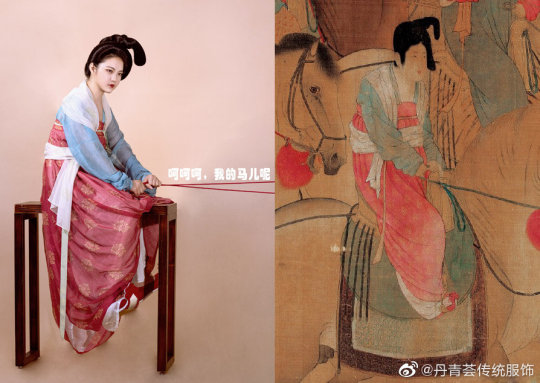
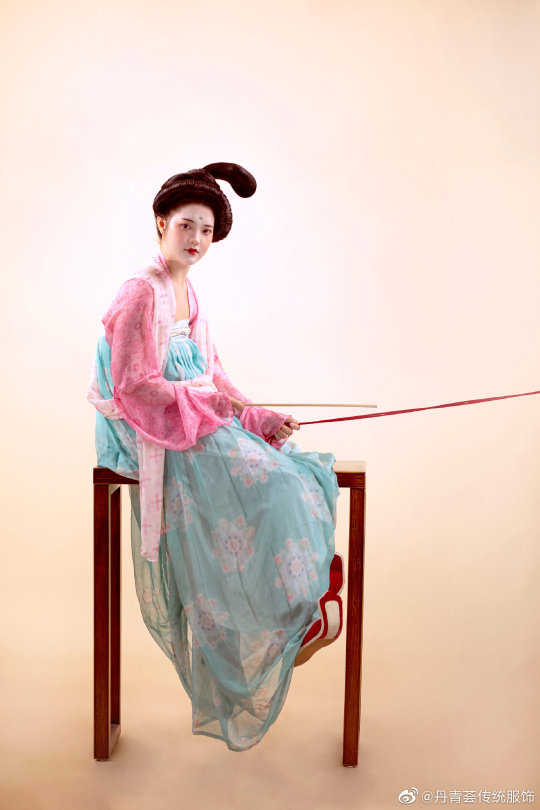
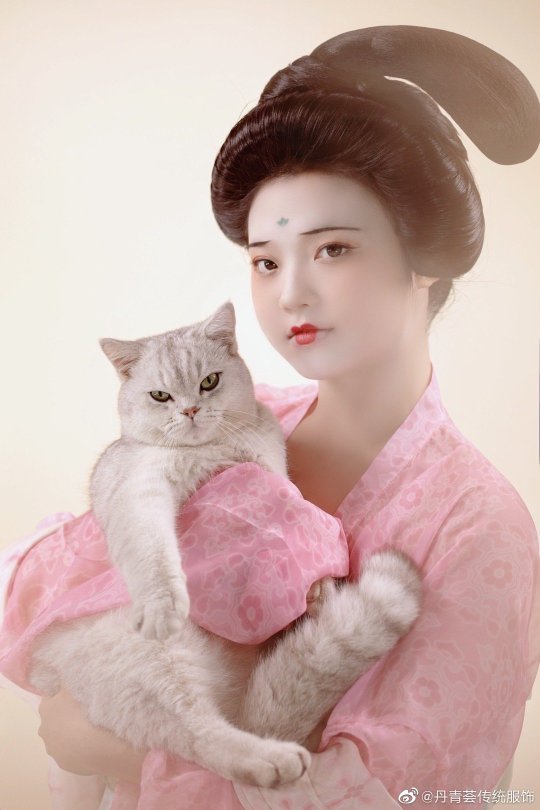
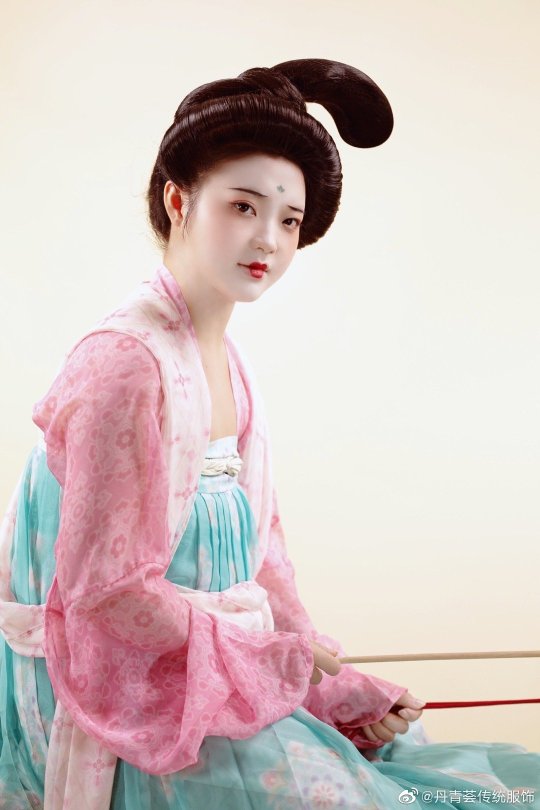
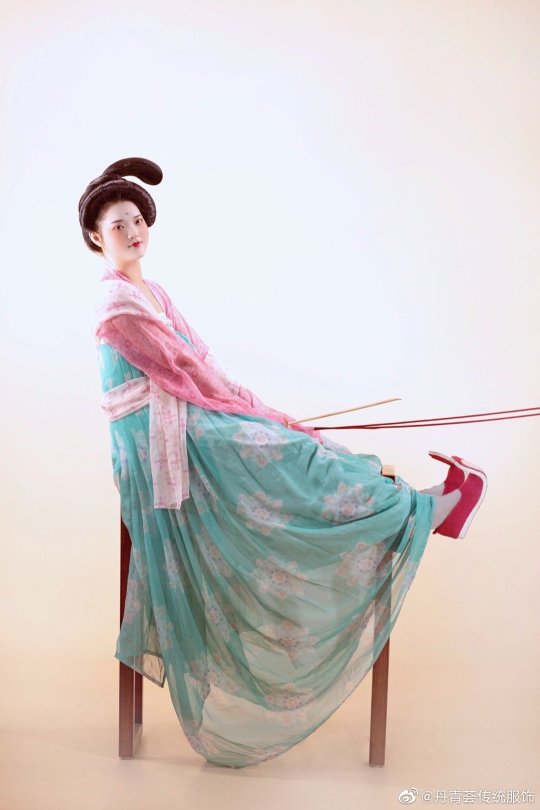
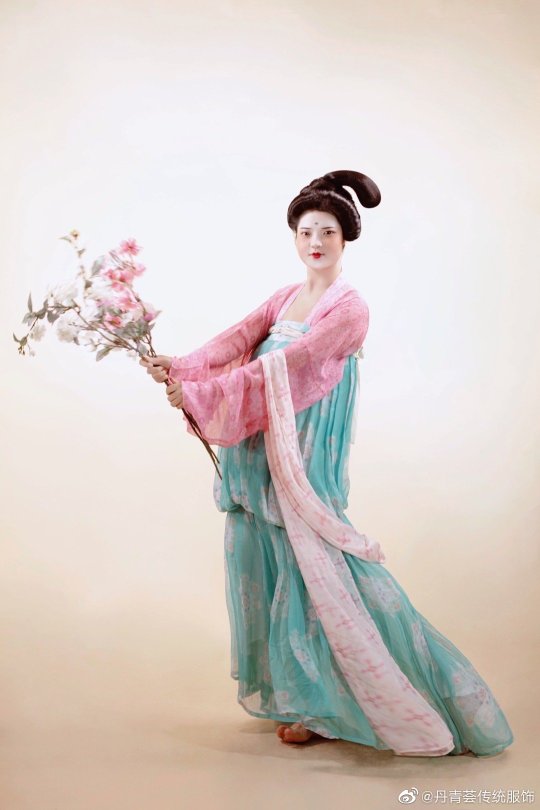
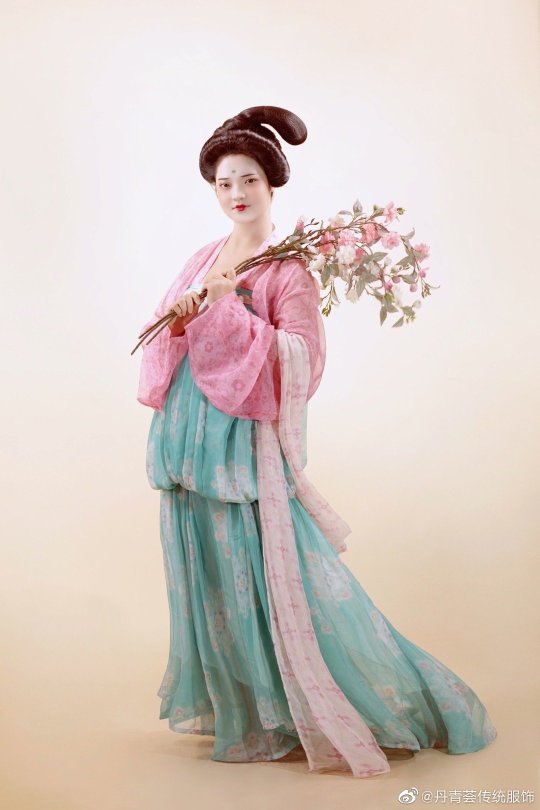

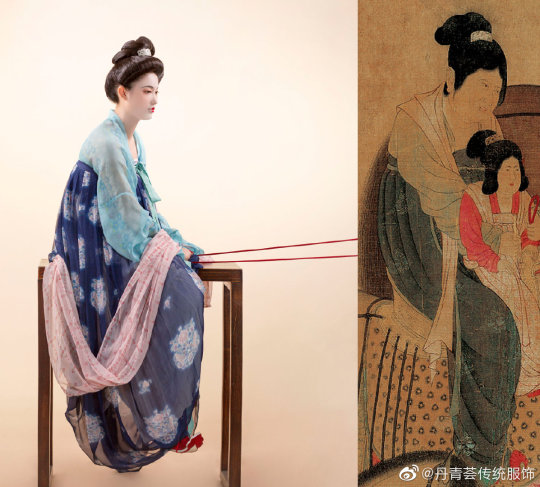

【Historical Reference Artifacts】:
Tang Dynasty Painting <虢国夫人游春图/Lady Guoguo's Spring Outing >
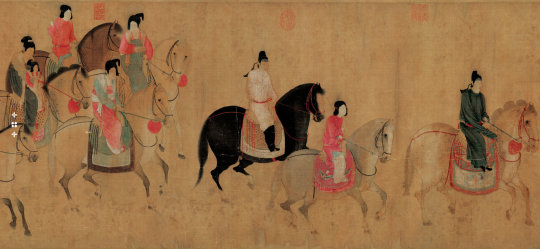


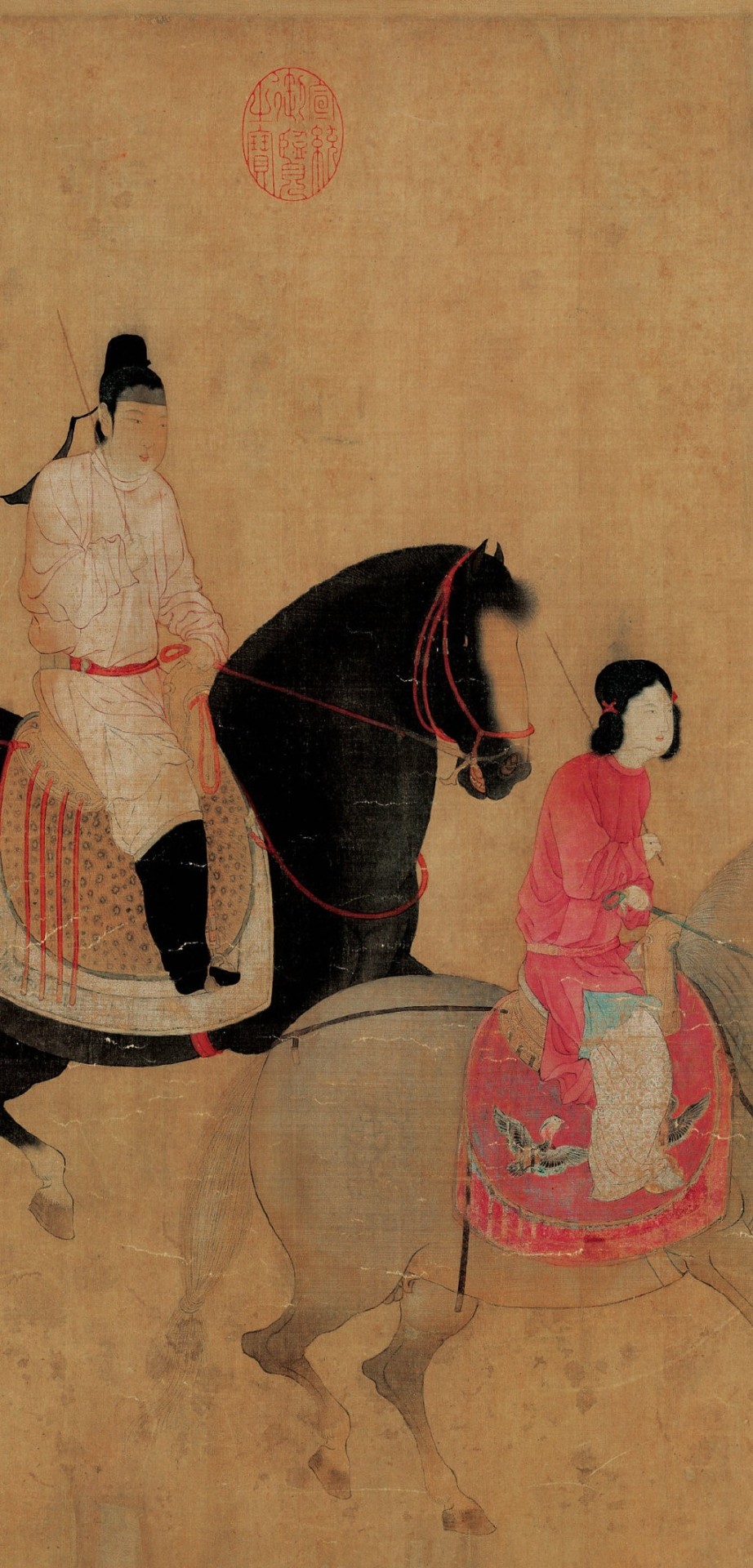
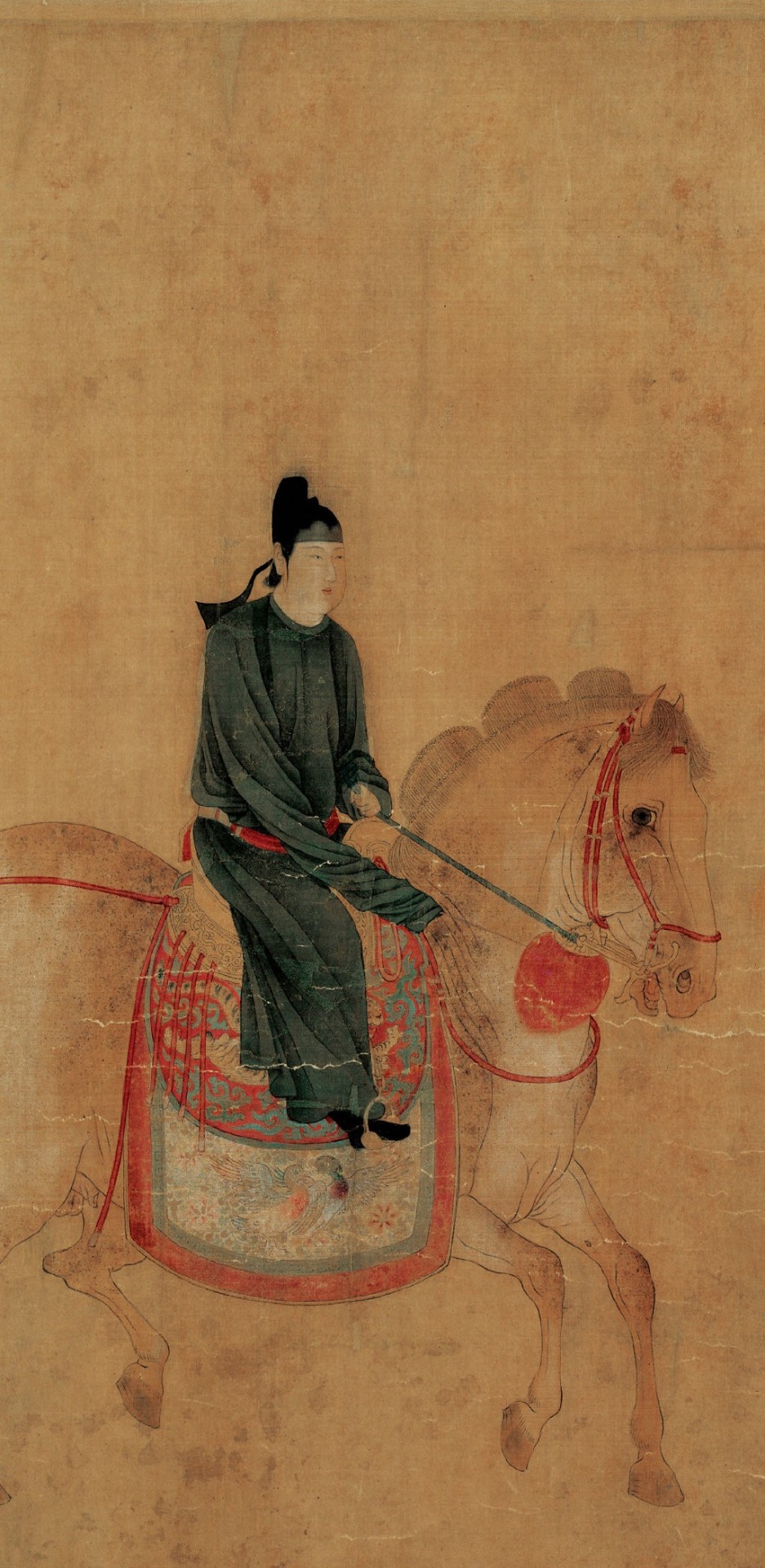
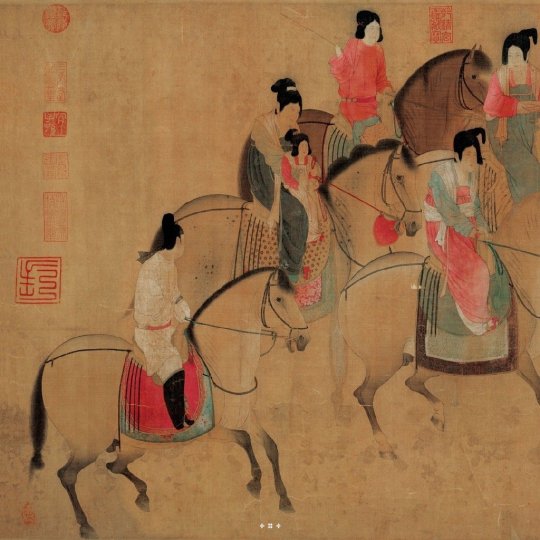
[Hanfu · 漢服]Chinese Tang Dynasty (960–1127 AD) Traditional Clothing Hanfu Based On Tang Dynasty Painting <虢国夫人游春图/Lady Guoguo's Spring Outing>
————————
Recreation Work:@丹青荟传统服饰
Weibo:https://weibo.com/6311444174/L7n6oF3jh
————————
#Chinese Hanfu#Tang Dynasty (960–1127 AD)#虢国夫人游春图/Lady Guoguo's Spring Outing#hanfu#hanfu history#hanfu accessories#hanfu_challenge#chinese historical fashion#chinese traditional clothing#china#chinese#Chinese Costume#chinese style#丹青荟传统服饰#漢服#汉服#China History#chinese art#shanqun#pibo
147 notes
·
View notes
Photo
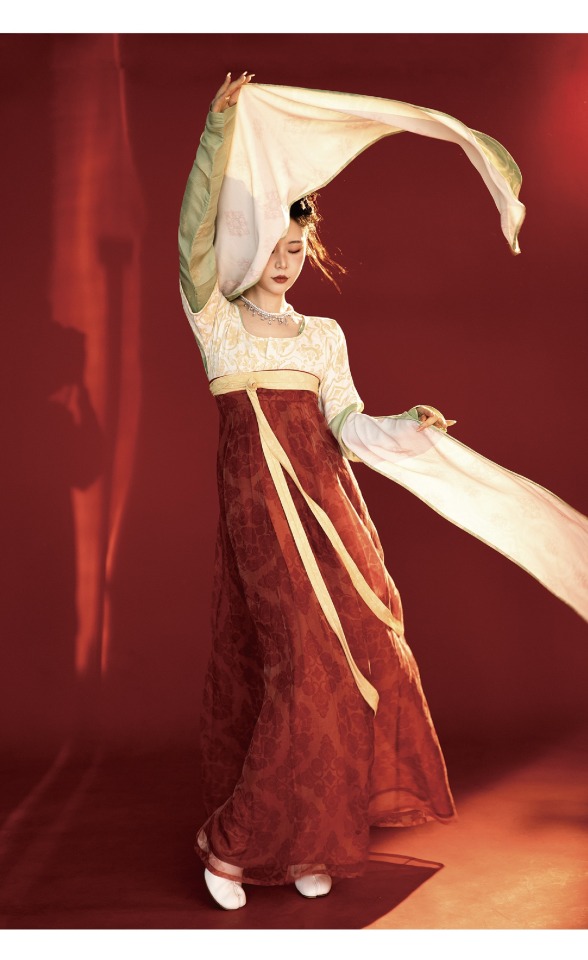





tanling shanqun by 嵠上
91 notes
·
View notes
Text
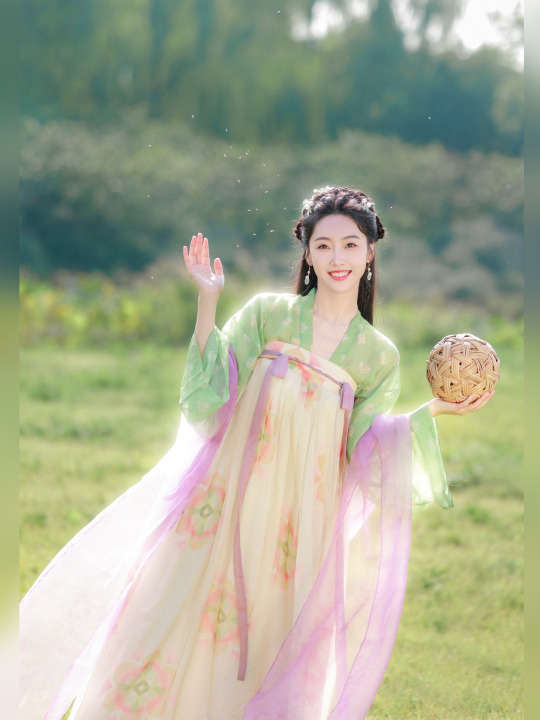





Spring Outing - Qixiong Shanqun
Chinese actor Lulu Xuan
309 notes
·
View notes
Note
Hello, I would like to communicate that it would be better if you change "modernized hanfu" into "hanfu theme modern dresses" because most of those dresses are actually Western dresses with classical Chinese element woven into their designs.
Hi, thanks for the question, and sorry for taking ages to reply!
I actually don't use the term "modernized hanfu" anymore, as it tends to imply that "traditional" hanfu isn't compatible with modern living, and/or equate modernity with Westernization, neither of which I agree with.
Instead of the loaded term "modernized hanfu" with its problematic implications, here are the two terms I do use:
1) Modified hanfu/改良汉服 (gailiang hanfu) - "gailiang/改良" is defined as "improved" or "reformed", but I don't like how these words imply that "traditional" hanfu is somehow inferior to hanfu that's been altered, so I use the neutral word "modified" instead as its English equivalent. I use the term "modified hanfu" to describe garments that are mostly constructed using traditional methods, but may have non-traditional alterations, including: shortened hems, non-traditional materials (e.g. lace, denim, leather), non-traditional parts (e.g. pockets, buttons, zippers, elastic, ruffles, bows), etc.
For example, below is a modified hanfu outfit from Yuan Shan Qiao/远山乔. At first glance it might not look like hanfu, but this is actually a Ming dynasty-style outfit comprised of a standing-collar short shan, square-collar bijia, and shortened mamianqun. Whimsical lace accents and accessories complete the "Alice in Wonderland" vibe:

2) Hanyuansu/汉元素 - "han/汉" is short for "hanfu", and "yuansu/元素" means "element(s)". Thus, "hanyuansu" is a term that refers to clothing with elements of hanfu. I also like to think of it as "hanfu-inspired" clothing. I use the term "hanyuansu" to describe garments that incorporate elements of hanfu (e.g. patterns, motifs, embroidery, etc.) but are constructed using non-traditional shapes and methods. "Hanyuansu" can be used to describe what anon's referring to in their message - Western dresses with classical Chinese element woven into their designs.
For example, below is a hanyuansu outfit from Chuan Dai/川黛. At first glance, it looks like a regular two-piece ruqun/shanqun with modified sleeves. However, this is actually a one-piece dress, with the top and skirt sections sewn together. As such, this is not hanfu, but rather hanyuansu made to resemble hanfu:
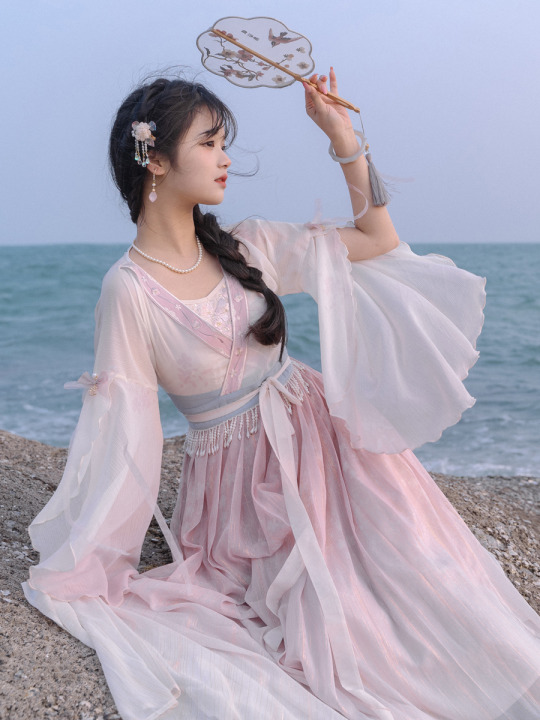
With that being said, the distinction between "modified hanfu" and "hanyuansu" isn't always clear-cut, and there is often a lot of overlap between them. Therefore, the two terms are used interchangeably in many cases.
There are more examples in my modified hanfu and hanyuansu tags. Bonus: I also have a post with recs for modified hanfu/hanyuansu shops here.
Hope this helps!
#hanfu#modified hanfu#hanyuansu#terminology#reference#ask#reply#>100#chinese fashion#chinese clothing#china
144 notes
·
View notes
Note
Was the short Aoqun of the Ming popular in the early period and then the longer styles later or were both at the same time used?
And is there a specific name in Chinese for longer styles aoqun? I wanna search up more because they’re really pretty
Generically speaking, the length of robes in aoqun gradually increased as the Ming Dynasty progressed. Though if you would like to be more specific, there were multiple times when this change reversed, such as in the late 15th century and mid 16th century. There is no specific name for longer aoqun, since all Ming Dynasty womenswear ensembles were technically called aoqun (or shanqun, "shirt and skirt"), and the length is just a difference in decade/era. The bulk of longer robes sold by hanfu shops that I've seen are those in the early 17th century i.e. end-of-Ming styles, with a standing collar and giant sleeves, so perhaps you could look for those. The search terms used for these is 立领长衫, or "standing collar long shirt".

Source see watermark
Snippet of 真武灵应图册, ca. second quarter 15th century, showing short women's robe.

Source
End-of-Ming style aoqun by hanfu shop 云出岫汉服.
95 notes
·
View notes